power steering Citroen JUMPY MULTISPACE 2011 2.G Owner's Manual
[x] Cancel search | Manufacturer: CITROEN, Model Year: 2011, Model line: JUMPY MULTISPACE, Model: Citroen JUMPY MULTISPACE 2011 2.GPages: 268, PDF Size: 10.1 MB
Page 30 of 268
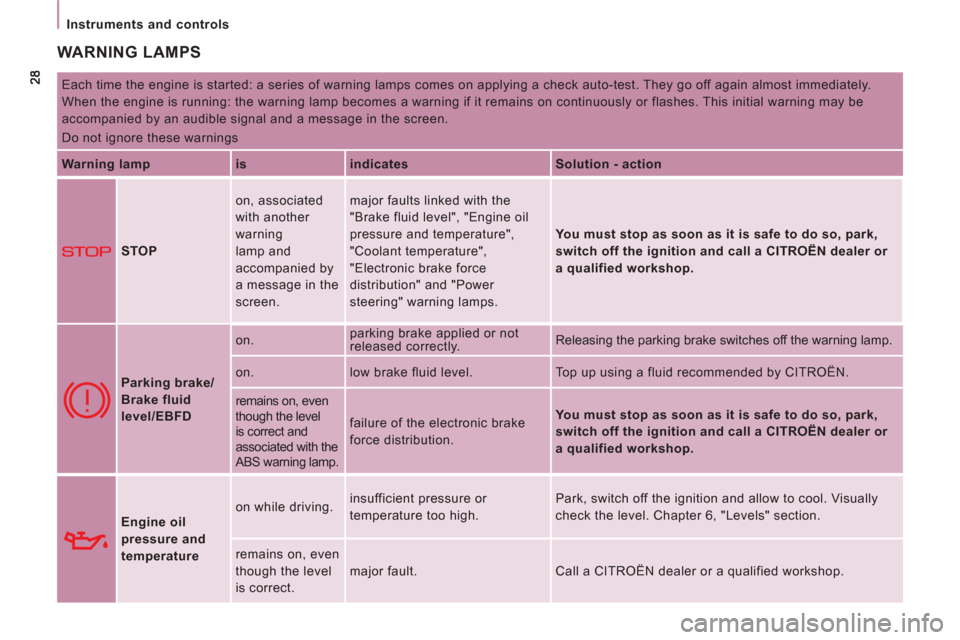
Instruments and controls
WARNING LAMPS
Each time the engine is started: a series of warning lamps comes on applying a check auto-test. They go off again almost immediately.
When the engine is running: the warning lamp becomes a warning if it remains on continuously or flashes. This initial warning may be
accompanied by an audible signal and a message in the screen.
Do not ignore these warnings
Warning lamp
is
indicates
Solution - action
STOP on, associated
with another
warning
lamp and
accompanied by
a message in the
screen. major faults linked with the
"Brake fluid level", "Engine oil
pressure and temperature",
"Coolant temperature",
"Electronic brake force
distribution" and "Power
steering" warning lamps.
You must stop as soon as it is safe to do so, park,
switch off the ignition and call a CITROËN dealer or
a qualified workshop.
Parking brake/
Brake fluid
level/EBFD on. parking brake applied or not
released correctly. Releasing the parking brake switches off the warning lamp.
on. low brake fluid level. Top up using a fluid recommended by CITROËN.
remains on, even
though the level
is correct and
associated with the
ABS warning lamp. failure of the electronic brake
force distribution.
You must stop as soon as it is safe to do so, park,
switch off the ignition and call a
CITROËN dealer or
a qualified workshop.
Engine oil
pressure and
temperature on while driving. insufficient pressure or
temperature too high. Park, switch off the ignition and allow to cool. Visually
check the level. Chapter 6, "Levels" section.
remains on, even
though the level
is correct. major fault. Call a CITROËN dealer or a qualified workshop.
Page 33 of 268
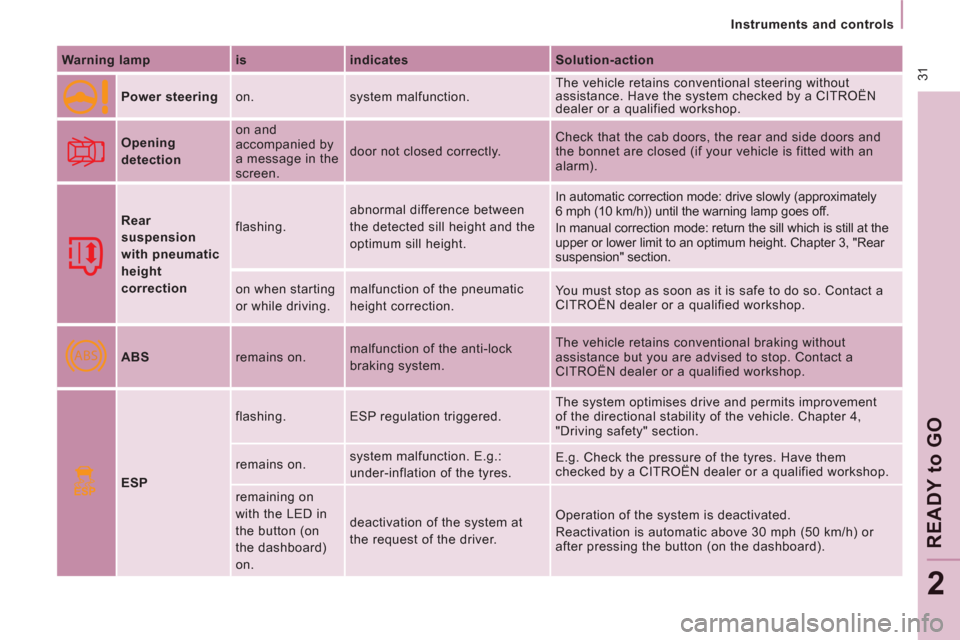
ABS
ESP
31
Instruments and controls
READY
to
GO
2
Warning lamp
is
indicates
Solution-action
Power steering on. system malfunction. The vehicle retains conventional steering without
assistance. Have the system checked by a CITROËN
dealer or a qualified workshop.
Opening
detection on and
accompanied by
a message in the
screen. door not closed correctly. Check that the cab doors, the rear and side doors and
the bonnet are closed (if your vehicle is fitted with an
alarm).
Rear
suspension
with pneumatic
height
correction flashing. abnormal difference between
the detected sill height and the
optimum sill height. In automatic correction mode: drive slowly (approximately
6 mph (10 km/h)) until the warning lamp goes off.
In manual correction mode: return the sill which is still at the
upper or lower limit to an optimum height. Chapter 3, "Rear
suspension" section.
on when starting
or while driving. malfunction of the pneumatic
height correction. You must stop as soon as it is safe to do so. Contact a
CITROËN dealer or a qualified workshop.
ABS remains on. malfunction of the anti-lock
braking system. The vehicle retains conventional braking without
assistance but you are advised to stop. Contact a
CITROËN dealer or a qualified workshop.
ESP flashing. ESP regulation triggered. The system optimises drive and permits improvement
of the directional stability of the vehicle. Chapter 4,
"Driving safety" section.
remains on. system malfunction. E.g.:
under-inflation of the tyres. E.g. Check the pressure of the tyres. Have them
checked by a CITROËN dealer or a qualified workshop.
remaining on
with the LED in
the button (on
the dashboard)
on. deactivation of the system at
the request of the driver.
Operation of the system is deactivated.
Reactivation is automatic above 30 mph (50 km/h) or
after pressing the button (on the dashboard).
Page 115 of 268
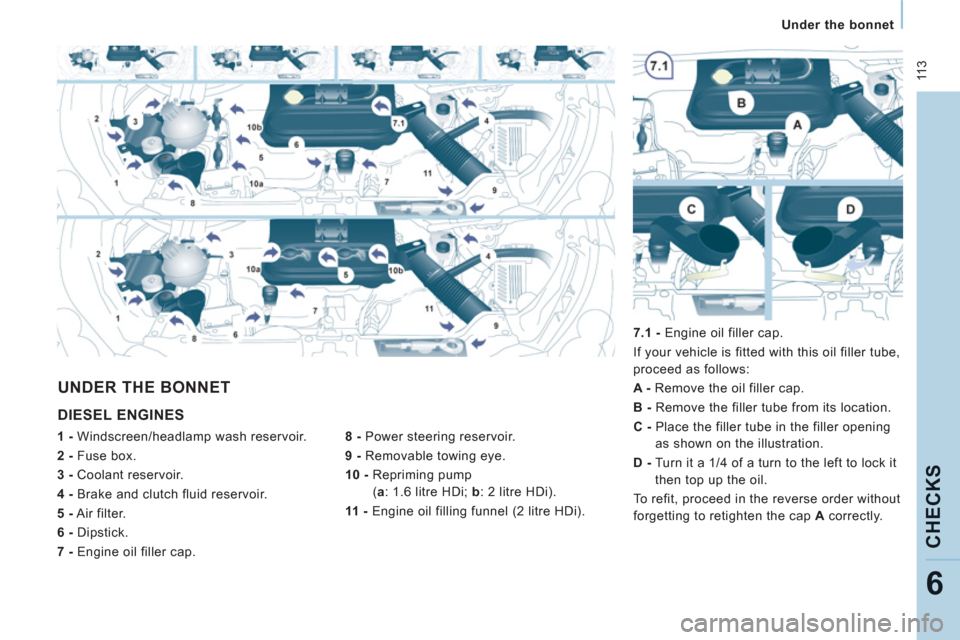
11 3
Under the bonnet
CHECK
S
6
DIESEL ENGINES
8 -
Power steering reservoir.
9 -
Removable towing eye.
10 -
Repriming pump
( a
: 1.6 litre HDi; b
: 2 litre HDi).
11 -
Engine oil filling funnel (2 litre HDi).
UNDER THE BONNET
1 -
Windscreen/headlamp wash reservoir.
2 -
Fuse box.
3 -
Coolant reservoir.
4 -
Brake and clutch fluid reservoir.
5 -
Air filter.
6 -
Dipstick.
7 -
Engine oil filler cap.
7.1 -
Engine oil filler cap.
If your vehicle is fitted with this oil filler tube,
proceed as follows:
A -
Remove the oil filler cap.
B -
Remove the filler tube from its location.
C -
Place the filler tube in the filler opening
as shown on the illustration.
D -
Turn it a 1/4 of a turn to the left to lock it
then top up the oil.
To refit, proceed in the reverse order without
forgetting to retighten the cap A
correctly.
Page 116 of 268
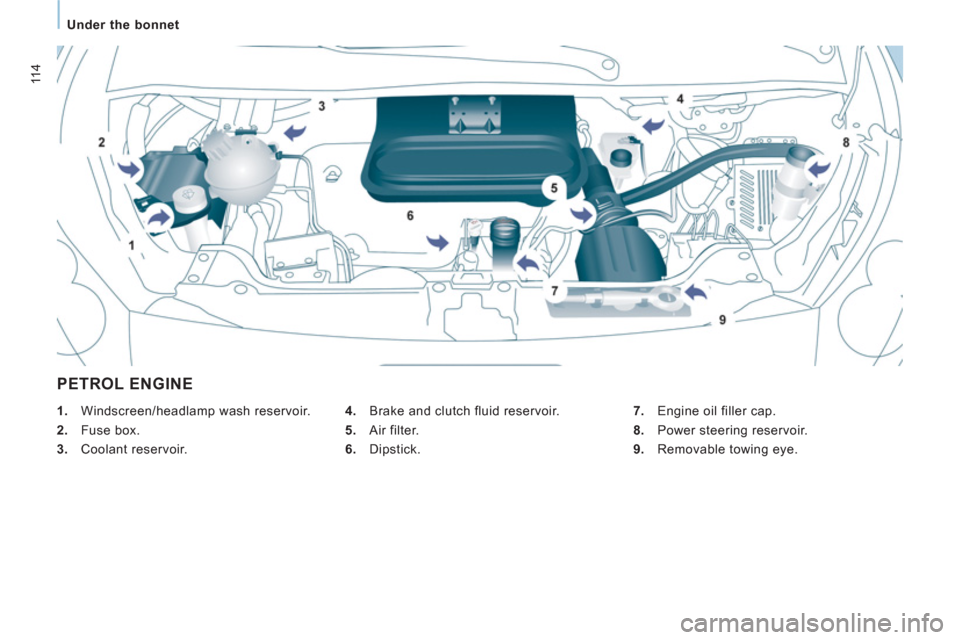
11 4
Under the bonnet
PETROL ENGINE
4.
Brake and clutch fluid reservoir.
5.
Air filter.
6.
Dipstick.
1.
Windscreen/headlamp wash reservoir.
2.
Fuse box.
3.
Coolant reservoir.
7.
Engine oil filler cap.
8.
Power steering reservoir.
9.
Removable towing eye.
Page 141 of 268
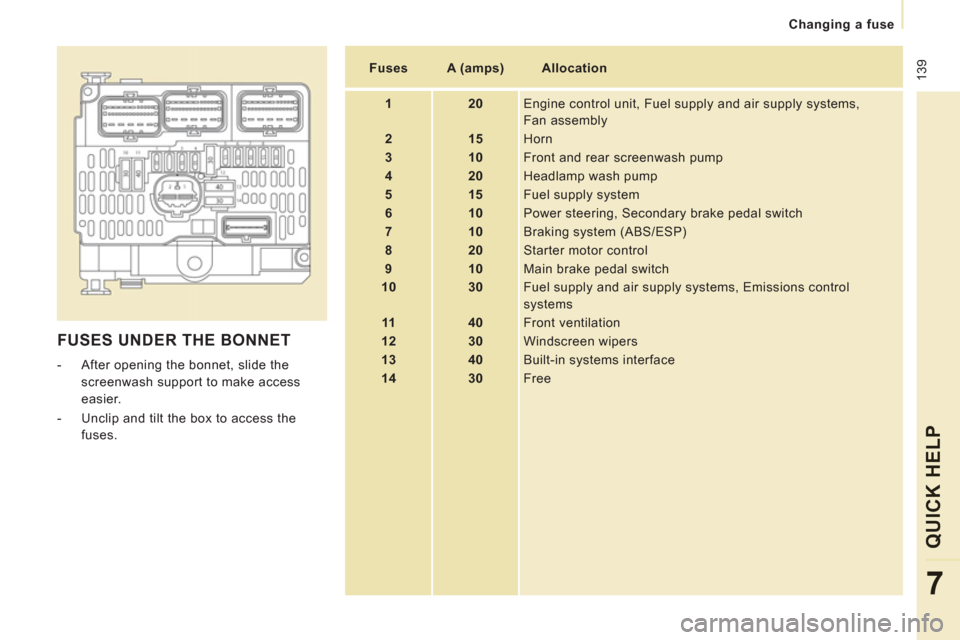
139
Changing a fuse
QUICK HEL
P
7
FUSES UNDER THE BONNET
- After opening the bonnet, slide the
screenwash support to make access
easier.
- Unclip and tilt the box to access the
fuses.
Fuses
A (amps)
Allocation
1
20
Engine control unit, Fuel supply and air supply systems,
Fan assembly
2
15
Horn
3
10
Front and rear screenwash pump
4
20
Headlamp wash pump
5
15
Fuel supply system
6
10
Power steering, Secondary brake pedal switch
7
10
Braking system (ABS/ESP)
8
20
Starter motor control
9
10
Main brake pedal switch
10
30
Fuel supply and air supply systems, Emissions control
systems
11
40
Front ventilation
12
30
Windscreen wipers
13
40
Built-in systems interface
14
30
Free
Page 144 of 268
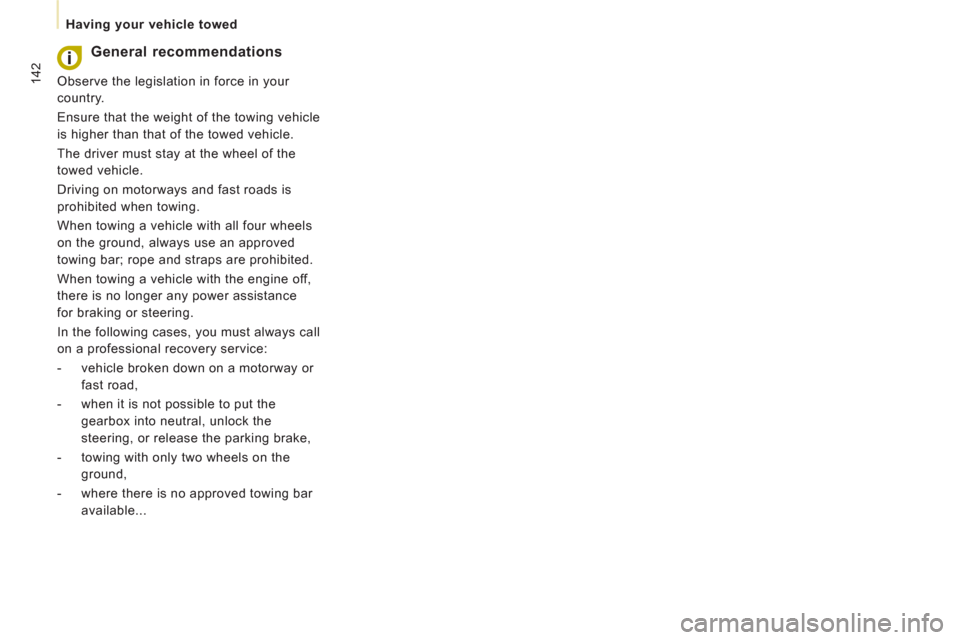
142
Having your vehicle towed
General recommendations
Observe the legislation in force in your
country.
Ensure that the weight of the towing vehicle
is higher than that of the towed vehicle.
The driver must stay at the wheel of the
towed vehicle.
Driving on motorways and fast roads is
prohibited when towing.
When towing a vehicle with all four wheels
on the ground, always use an approved
towing bar; rope and straps are prohibited.
When towing a vehicle with the engine off,
there is no longer any power assistance
for braking or steering.
In the following cases, you must always call
on a professional recovery service:
- vehicle broken down on a motorway or
fast road,
- when it is not possible to put the
gearbox into neutral, unlock the
steering, or release the parking brake,
- towing with only two wheels on the
ground,
- where there is no approved towing bar
available...
Page 261 of 268
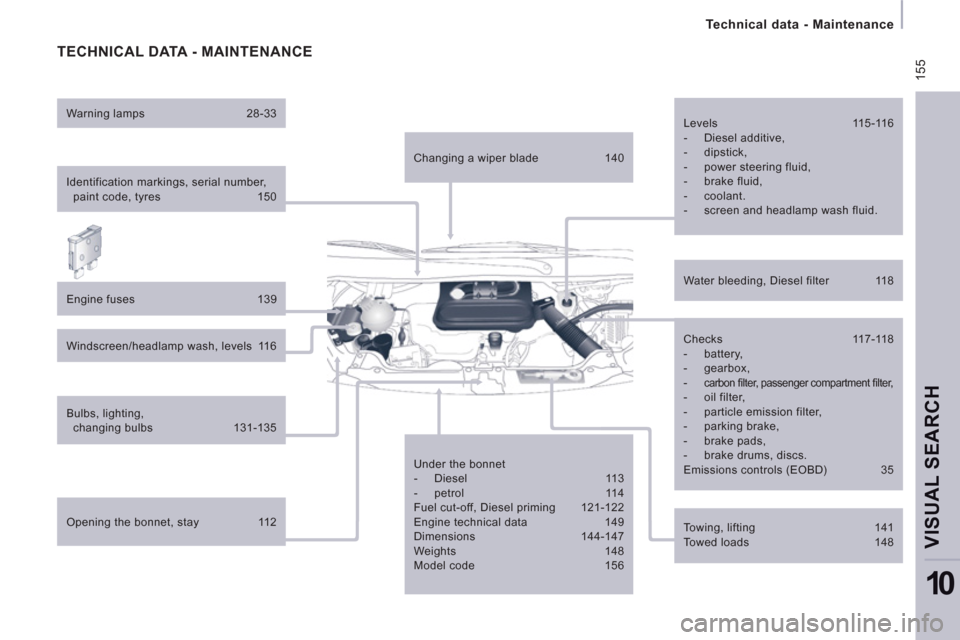
155
Technical data - Maintenance
VISUAL SEARC
H
10
TECHNICAL DATA - MAINTENANCE
Identification markings, serial number,
paint code, tyres 150
Engine fuses 139
Windscreen/headlamp wash, levels 116
Bulbs, lighting,
changing bulbs 131-135
Checks 117-118
- battery,
- gearbox,
-
carbon fi lter, passenger compartment fi lter,
- oil filter,
- particle emission filter,
- parking brake,
- brake pads,
- brake drums, discs.
Emissions controls (EOBD) 35
Water bleeding, Diesel filter 118
Under the bonnet
- Diesel 113
- petrol 114
Fuel cut-off, Diesel priming 121-122
Engine technical data 149
Dimensions 144-147
Weights 148
Model code 156
Opening the bonnet, stay 112
Levels 115-116
- Diesel additive,
- dipstick,
- power steering fluid,
- brake fluid,
- coolant.
- screen and headlamp wash fluid.
Towing, lifting 141
Towed loads 148
Warning lamps 28-33
Changing a wiper blade 140